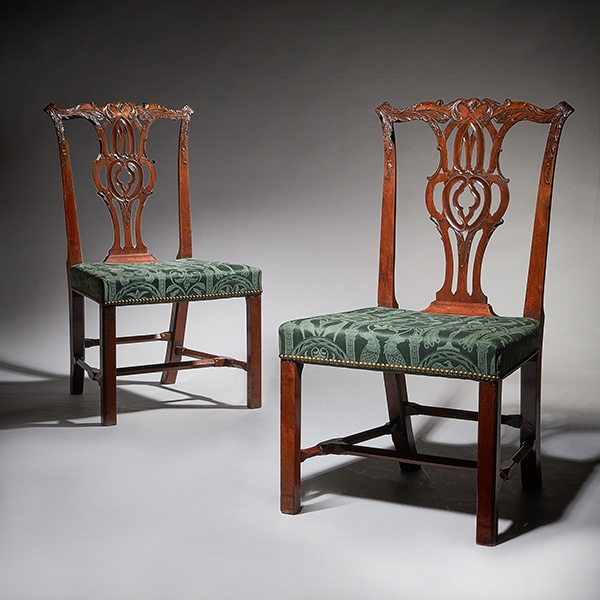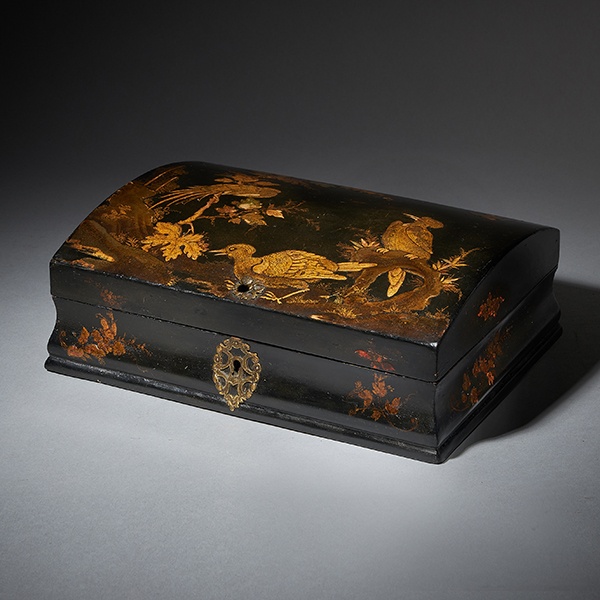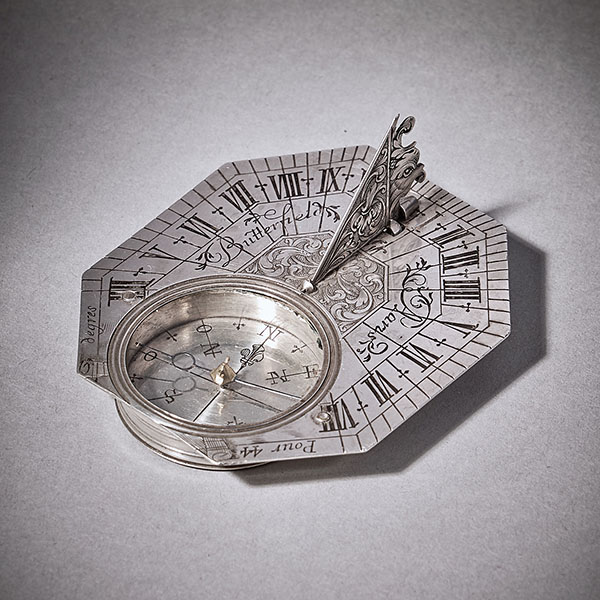Magnificent 18th Century Striking Dutch Amsterdam Burl Walnut Longcase Clock
£26,000
Request Information
Follow Us
Magnificent 18th Century Striking Dutch Amsterdam Burl Walnut Longcase Clock
An impressive Dutch longcase clock with a burr walnut veneered oak case, signed on the chapter ring Pieter Brandt Amsterdam, c. 1745-50. The hood of this clock has a broken arch top pediment with very fine elaborate fretwork functioning as sound frets, as well as a prominent asymmetrically carved ornament. It is surmounted by three very fine gilt wooden statuettes depicting a Chronos figure flanked by two Mars figures. The shaped door in the trunk is embellished by rosewood inlays and has a lenticle with a classic brass surround in the shape of the goddess Europa on her bull, through which the movement of the pendulum can be seen. The impressive base is fortified by buttress-like corners and rests on ball feet
The superb arched brass dial has a silvered Roman and Arabic chapter ring, a subsidiary seconds ring above the middle and a date aperture above the VI. Left and right of the middle are a month aperture showing the month, a symbolic representation of the month and the number of days in the month, as well as a day aperture showing the day of the week and a symbolic representation of the day. The phases of the moon are shown in the arch, as well as the time of high water in Amsterdam, which was important to the tradesmen in the 18th century. The time is indicated by a pair of blued steel hands on the silvered chapter ring, which is surrounded by gilt cast brass spandrels in the corners depicting the four seasons.
The weight-driven eight-day movement consists of going and striking trains, as well as an alarm. The going train has anchor escapement and a seconds pendulum. The quarter striking train indicates the hours and half hours fully on two bells differing in pitch (Dutch striking) and the quarters with one stroke. It is regulated by a rack mechanism and can be repeated at will by pulling a cord behind the door. The weight-driven alarm is set by a silvered disc behind the hands, the tail of the hour hand indicating the alarm time.
Measures: Overall height 2.85 m. (9 ft 3 inch)
The maker
Pieter Brandt was from a family of clockmakers and was active as a clockmaker from c.1740-1785. Not much is known about him, but it is abundantly clear from his work that he was an excellent maker.
Condition
Good. Wear consistent with age and use.
Dimensions
Height: 112.21 in. (285 cm)
Width: 23.23 in. (59 cm)
Depth: 12.6 in. (32 cm)
PREVIOUSLY SOLD
No Results Found
The page you requested could not be found. Try refining your search, or use the navigation above to locate the post.
No Results Found
The page you requested could not be found. Try refining your search, or use the navigation above to locate the post.
YOU MAY ALSO LIKE

Pair of 18th Century George III Carved Mahogany Chippendale Chairs
Pair of 18th Century George III Carved Mahogany Chippendale Chairs £8,900Follow UsPair of 18th Century George III Carved Mahogany Chippendale Chairs A simply superb pair of carved George III mahogany chairs, C.1770. Condition Good. Wear...

18th Century Japanned Chinoiserie Dome-Topped Box, Circa 1715-1725
18th Century Japanned Chinoiserie Dome-Topped Box, Circa 1715-1725 £3,800Follow Us18th Century Japanned Chinoiserie Dome-Topped Box, Circa 1715-1725 Early 18th century George I Japanned Chinoiserie dome-topped box, Circa 1715-1725. England or...

18th Century George III Mahogany Wine Cooler or Cellarette
18th Century George III Mahogany Wine Cooler or Cellarette £4,600Follow Us18th Century George III Mahogany Wine Cooler or Cellarette A fine and well-figured George III mahogany hexagonal wine cooler or cellarette on the original stand, C....

Striking 19th Century Carriage Clock with a Gilt-Brass Corniche Case by Grohé
Striking 19th Century Carriage Clock with a Gilt-Brass Corniche Case by Grohé £3,995 Follow UsStriking 19th Century Carriage Clock with a Gilt-Brass Corniche Case by Grohé Striking carriage clock with a gilt-brass corniche case by Grohé,...

Rare Silver Pocket Sundial and Compass by Michael Butterfield, Paris, circa 1700
Rare Silver Pocket Sundial and Compass by Michael Butterfield, Paris, circa 1700 £4,900 Follow UsRare Silver Pocket Sundial and Compass by Michael Butterfield, Paris, circa 1700 A beautiful, rare solid silver Anglo-French octagonal pocket...

Engraved Eight-Day Striking and Repeating Carriage Clock by Perregaux Au Locle
Engraved Eight-Day Striking and Repeating Carriage Clock by Perregaux Au Locle Follow UsEngraved Eight-Day Striking and Repeating Carriage Clock by Perregaux Au Locle The superb engraved gilt gorge brass case has facetted glass panels to all...

Pair of 18th Century George III Carved Mahogany Chippendale Chairs
Pair of 18th Century George III Carved Mahogany Chippendale Chairs £8,900Follow UsPair of 18th Century George III Carved Mahogany Chippendale Chairs A simply superb pair of carved George III mahogany chairs, C.1770. Condition Good. Wear...

18th Century Japanned Chinoiserie Dome-Topped Box, Circa 1715-1725
18th Century Japanned Chinoiserie Dome-Topped Box, Circa 1715-1725 £3,800Follow Us18th Century Japanned Chinoiserie Dome-Topped Box, Circa 1715-1725 Early 18th century George I Japanned Chinoiserie dome-topped box, Circa 1715-1725. England or...

18th Century George III Mahogany Wine Cooler or Cellarette
18th Century George III Mahogany Wine Cooler or Cellarette £4,600Follow Us18th Century George III Mahogany Wine Cooler or Cellarette A fine and well-figured George III mahogany hexagonal wine cooler or cellarette on the original stand, C....

Striking 19th Century Carriage Clock with a Gilt-Brass Corniche Case by Grohé
Striking 19th Century Carriage Clock with a Gilt-Brass Corniche Case by Grohé £3,995 Follow UsStriking 19th Century Carriage Clock with a Gilt-Brass Corniche Case by Grohé Striking carriage clock with a gilt-brass corniche case by Grohé,...

Rare Silver Pocket Sundial and Compass by Michael Butterfield, Paris, circa 1700
Rare Silver Pocket Sundial and Compass by Michael Butterfield, Paris, circa 1700 £4,900 Follow UsRare Silver Pocket Sundial and Compass by Michael Butterfield, Paris, circa 1700 A beautiful, rare solid silver Anglo-French octagonal pocket...

Engraved Eight-Day Striking and Repeating Carriage Clock by Perregaux Au Locle
Engraved Eight-Day Striking and Repeating Carriage Clock by Perregaux Au Locle Follow UsEngraved Eight-Day Striking and Repeating Carriage Clock by Perregaux Au Locle The superb engraved gilt gorge brass case has facetted glass panels to all...










